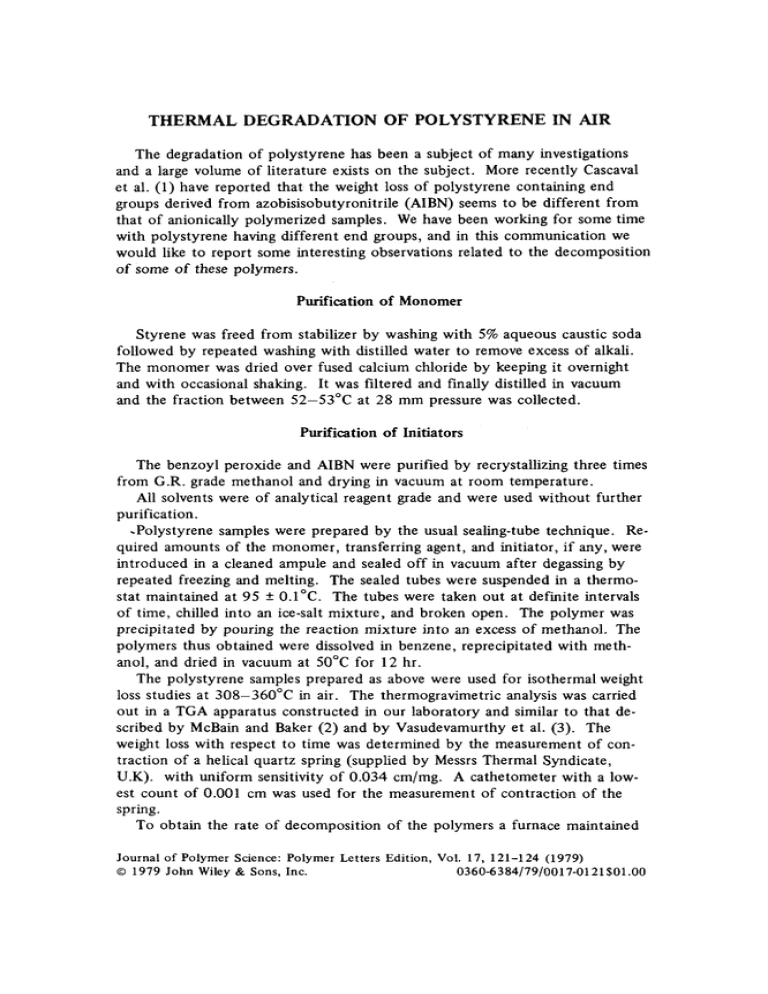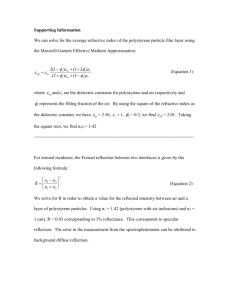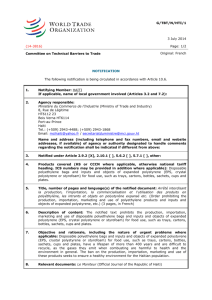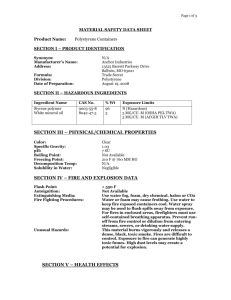IN THERMAL DEGRADATION OF POLYSTYRENE AIR
advertisement

THERMAL DEGRADATION OF POLYSTYRENE IN AIR The degradation of polystyrene has been a subject of many investigations and a large volume of literature exists on the subject. More recently Cascaval et al. (1) have reported that the weight loss of polystyrene containing end groups derived from azobisisobutyronitrile (AIBN) seems to be different from that of anionically polymerized samples. We have been working for some time with polystyrene having different end groups, and in this communication we would like to report some interesting observations related to the decomposition of some of these polymers. Purification of Monomer Styrene was freed from stabilizer by washing with 5% aqueous caustic soda followed by repeated washing with distilled water to remove excess of alkali. The monomer was dried over fused calcium chloride by keeping it overnight and with occasional shaking. It was filtered and finally distilled in vacuum and the fraction between 52-53°C at 28 mm pressure was collected. Purification of Initiators The benzoyl peroxide and AIBN were purified by recrystallizing three times from G.R. grade methanol and drying in vacuum at room temperature. All solvents were of analytical reagent grade and were used without further purification. .Polystyrene samples were prepared by the usual sealing-tube technique. Required amounts of the monomer, transferring agent, and initiator, if any, were introduced in a cleaned ampule and sealed off in vacuum after degassing by repeated freezing and melting. The sealed tubes were suspended in a thermostat maintained at 95 ? 0.1"C. The tubes were taken out at definite intervals of time, chilled into an ice-salt mixture, and broken open. The polymer was precipitated by pouring the reaction mixture into an excess of methanol. The polymers thus obtained were dissolved in benzene, reprecipitated with methanol, and dried in vacuum at 50°C for 12 hr. The polystyrene samples prepared as above were used for isothermal weight loss studies at 308-360°C in air. The thermogravimetric analysis was carried out in a TGA apparatus constructed in our laboratory and similar to that described by McBain and Baker (2) and by Vasudevamurthy et al. (3). The weight loss with respect to time was determined by the measurement of contraction of a helical quartz spring (supplied by Messrs Thermal Syndicate, U.K). with uniform sensitivity of 0.034 cm/mg. A cathetometer with a lowest count of 0.001 cm was used for the measurement of contraction of the spring. To obtain the rate of decomposition of the polymers a furnace maintained Journal of Polymer Science: Polymer Letters Edition, Vol. 17, 121-124 (1979) 0 1979 John Wiley & Sons, Inc. 0360-6384/79/0017-0121$01.00 POLYMER LETTERS EDITION 122 TABLE I Total Percent Weight Loss for Polystyrene Samplesa %male So. l o l j r s t y r e ne % wt.loss. with transferring agents’ and o r i n i t i a t o r . D.P. 1 AI 3x 94.4 2 Bernoyl peroxide 94.1 461. 3 Carbon t e t r a - 40.0 chloride. 60. 4 Pronobenzene 59.3 2506. 5 Benzene 57.2 4”lO. - 77.6 5 41. 10 366 3 t h y l a c e t a t e 73.4 1 Q57. a c e t i c acid 79.4 1016. ‘rethy1 e t h y l ketone iethylaaine 7 4 . ~0 1517. 65 .? ~ ~~~ aExperimental temperature: 308°C; total time: 2 hr; atmosphere: air. All samples except 1 and 2 were thermally polymerized. at constant temperature within 5 1°C was used in the experimental setup. The temperature of the furnace was measured with the help of a chrome-Alumel thermocouple with one of its junctions in the center of the furnace and just below the sample holder. Before determining the rate of decomposition, the furnace was maintained at the required temperature and was kept for 8 - 12 hr to attain equilibrium. For each run a sample of 50.0 mg was placed into a thin-walled cylindrical platinum hollow bucket (made of foil of 0.025 mm thickness). The bucket was placed in the furnace maintained at the required temperature and equilibrium was found to be attained within less than 1 min. The zero-time reading was taken after 1 min of insertion of the sample in the furnace and due correction made for any weight loss during this period. All the samples were studied under similar experimental conditions. The percent weight loss in each case was measured with definite intervals of time for 2 hr. The residual mass was checked gravimetrically. The percentage weight loss with respect to time is represented in Figure 1 and the total % weight loss is given in Table I . The weight loss experiment has been carried out at different temperatures POLYMER LETTERS EDITION 100 p 25 I 123 TEMPERATURE 308 50 I OC ?5 100 I I 5 t f I? W 3 5 Fig. 1. Percent weight loss of polystyrene samples at different times. Numbers refer to the sample as depicted in Table I . (308-360°C) and Table I is a representative one for 308°C. The experiments were repeated at least four times and found to be reproducible within experimental error. The foregoing results clearly show the significant difference in the extent of decomposition as dependent on the type of end group. Thus polystyrene with halogen end groups prepared in the presence of carbon tetrachloride undergoes only 40% weight loss as compared to 94.4% for samples prepared in the presence of AIBN or benzoyl peroxide and 77% for thermally polymerized sample. The extent of decomposition can be easily seen to be a function of the type of end group indicating that the cause of decomposition is end initiated. Although we would have expected a higher rate of decomposition for polystyrene sample having DP = 60.0 for carbon tetrachloride as compared to the thermally polymerized sample of DP = 5546.0,in actual experiment the reverse trend is noticed. Such wide variation is larger than would be accounted for by molecular weight effects. Also there is significant difference between POLYMER LETTERS EDITION 124 samples 5 and 6 which is quite surprising. We have carried out IR, UV, and mass spectral analysis, and have some tentative clue to their mode of behavior. At present we refrain from suggesting any mechanistic model for such differences until further work is carried out. References (1) C. N. Cascaval, S. Straus, D. W. Brown, and R. E. Florin, J . Polym. Sci. Symp., 57, 81-88 (1976). (2) J. W. McBain and A. M. Baker, J. Am. Chem. SOC.,48, 690 (1926). (3) A. R. Vasudevamurthy, D. S. Bharadwaz, and R. M. Mallya, Chem. Ind., 16, 300 (1956). Mahendra Singh U. S. Nandi Department of Inorganic and Physical Chemistry Indian Institute of Science Bangalore-560 012 India Received May 9 , 1978 Revised October 6, 1978





